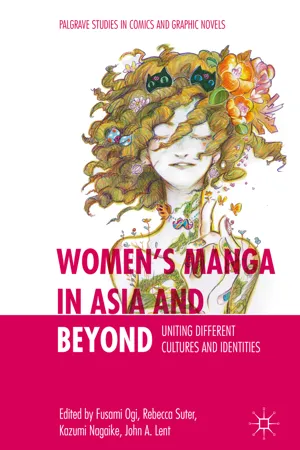This section focuses on using women’s manga in a transnational perspective, focusing on a range of different ways in which the label “shōjo manga” has performed an important role in the development of women’s comics beyond the Japanese context. Through a series of close readings of individual case studies from both Japan and Asia, the chapters in this section highlight how the label of shōjo manga functioned as a catalyzer for the creation of a new expressive space for women authors.
Tracing the representation of Asia in Japanese girls’ comics from the 1960 to the present, Fusami Ogi identifies three distinct and interconnected phases. In the early period, shōjo manga’s interest centers on the exoticization and feminization of Europe, often the Europe of the past, as exemplified by the proliferation of the trope of the princess. In this phase, Asia is notably absent, and even Japanese characters are portrayed as European-looking, with a drawing style that de-Asianizes them. Shōjo manga of the 1970s begins to complicate this picture, portraying Asian and mixed-race characters and Asian and transnational settings in a similar fantastical narrative and visual style. In the 1980s, in manga directed at an older demographic of women (ladies’ comics), more realistic portrayals of daily life in Asia begin to appear.
Tracing this history allows Ogi to present a poignant analysis of a series of works published in the 1990s and 2000s by young female authors from Southeast Asia, demonstrating that they use the conventions of shōjo manga to portray Asian culture in a complex, transnational, and glocalized perspective.
The next chapter introduces another complicating factor in the relationship between shōjo manga and Asia, namely, the representation of Australia as both proximate (“Asian”) and distant (“Western”) in Japanese girls’ comics. Focusing in particular on one case study, Yumiko Igarashi’s Georgie!, Suter shows how Australia, initially presented as an object of exotic fascination, comes to stand for nature, simplicity, and working-class values in contrast with the sophisticated, cold, and corrupt world of aristocratic England. This is representative of a broader trend in shōjo manga’s representation of Australia as a third space that Suter calls “near West,” a foreign space that is neither Euroamerican nor Japanese, neither self nor Other, and thus offers us a more nuanced vision of shōjo manga’s mechanisms of identification, projection, and exoticization of its cultural Others.
In the following chapter, Yukari Yoshihara analyzes adaptations of the works of Shakespeare, embodiments of the Western high culture, done by Japanese female manga artists with more or less explicit feminist agendas. Yoshihara argues that the resulting hybridization makes it possible for female artists to raise dissident voices against the Western elite authority of Shakespeare and expand the possibilities of manga, transgressing the boundaries between high culture and low culture, the West and the Rest, the authentic and the imitative.
Through a close reading of a number of different texts, Yoshihara demonstrates how by reinventing Shakespeare, a male artist mostly writing to glorify male heroes (in his tragedies) and to contain female protagonists within the boundaries dictated by heterosexist and patriarchal ideology of romantic love (in his comedies) into shōjo manga style, Japanese female manga artists create a world where “unfeminine” female characters can voice their own point of view and where sisterly bonds between women are preferred rather than male homosocial bonds.
The theme of “sisterly bonds” is central also to the next chapter, by Jessica Bauwens-Sugimoto, that focuses on the Belgian comic book series Yoko Tsuno , by Roger Leloup. Tracing the evolution of the series and its heroine, a Japanese engineer living in Belgium, from its inception to today from a gender studies perspective, through a combination of textual and visual analysis and ethnographic research on the readership, Bauwens-Sugimoto examines the changing representation of “Japaneseness” and “femininity” in the comic and its reception by (mostly male) Belgian readers.
Connecting the representation of the character of Yoko Tsuno as an unconventional powerful heroine to the importance given to female friendship/solidarity in the stories, Bauwens-Sugimoto is able to show how she is not portrayed in the stereotypical fashion of masculinized female superheroes who are “one of the boys” but rather as a genuinely new model of social and gender norms. The chapter thus shows how Franco-Belgian comics confront issues long dealt with in the world of manga (where as shown by other chapters in this collection, female artists, readers, and characters have been valued since the 1970s), and how this leads readers of all genders to appreciate strong female characters who are not specifically designed to cater to the male gaze.
Similarly focused on female heroines that are symbols of unconventional femininity, in this case those of Katsuji Matsumoto’s early shōjo manga, Ryan Holmberg’s chapter offers greater historical depth to our understanding of the trope of the Japanese tomboy by tracing its origins to the prewar period. Putting into critical perspective the conventional narrative that sees the origin of shōjo manga style in the 1920s magazine illustrations called jojōga (lyrical pictures), that portrayed delicate, conventionally feminine idealized young women, Holmberg shows that Matsumoto drew girls’ manga in a number of different styles and relied on a wider range of sources for inspiration, such as the works of Walt Disney and the media discourse on the moga (modern girl), that provided more powerful, less conventionally feminine models.
Analyzing Matsumoto’s tomboy characters like Kurumi-chan and Clover allows Holmberg to complicate our understanding of the relationship between prewar and postwar girls’ manga, and to construct a more nuanced picture of the “shōjo manga label” that is central to this section of the book. The chapter thus constitutes both an effective conclusion for the section and a transition to the following section, examining in detail the work of Asian women cartoonists and the way they critically engaged with the label of “shōjo manga.”
